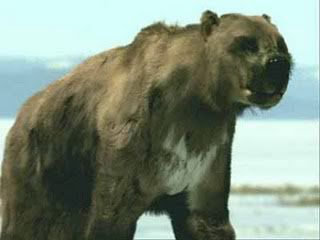Post by grrraaahhh on Feb 20, 2011 7:41:21 GMT -9
Interrelationship of Black Bears to Moose and Forest Succession in the Northern Coniferous Forest
Abstract
We compared characteristics of 2 black bear (Ursus americanus) populations living in middle-aged (1947 burn area) and recent (1969 burn area) burned forest stands on the Kenai Peninsula, Alaska, during 1982-87. Densities of bears on the 1947 ($205\ \text{bears}/1,000\ {\rm km}^{2}$) and 1969 ($265\ \text{bears}/1,000\ {\rm km}^{2}$) burn areas were similar. Sex ratios of the 2 populations were not different (P = 0.478), but there were significantly more (P = 0.007) females than males in both areas. Age structures of the population were different (P = 0.003). There were more yearlings in the 1969 burn area due to higher cub production and survival. Female bears in the 1947 burn bred at a later age (P = 0.03) (5.8 yrs) than females in the 1969 burn (4.6 yrs). Females in the 1947 burn also had a longer interval between successful weaning of yearlings (P = 0.03) (2.4 yrs) than females in the 1969 burn (2.0 yrs). Weights of adult females and yearlings in the 1947 burn area were significantly less (P < 0.001) than those in the 1969 burn area. Food habits and food abundance in the 2 areas were similar except that bears in the 1947 burn area consumed more lowbush cranberry (Vaccinium vitis-idaea) and bears in the 1969 burn area consumed approximately 4 times more moose calves (Alces alces) per individual. Most bears in both areas migrated each summer from their traditional use areas to old-growth forest where they consumed American devilsclub (Oplopanax horridus) fruit. Timing of migration and length of stay in American devilsclub stands were related to fruit abundance. Estimates of survival using the Kaplan-Meier procedure were significantly lower (P = 0.05) for cubs in the 1947 burn (0.74) than in the 1969 burn (0.91) but higher for subadult females in the 1947 burn. Survival was not different for all other age and sex classes of bears. Human, primarily hunters, caused 85% of the deaths (n = 35) in the 1969 burn, but only 52% (n = 31) in the 1947 burn, where there also was significant mortality from black bears (13%) and brown bears (U. arctos) (10%). Vigor of black bears was linked to moose abundance. The superior growth and reproduction of black bears in the 1969 burn was attributed to a greater consumption of moose calves. Our findings demonstrated a link between neonatal predation and demographics of bear populations.
PDF link:http://www.google.com/url?q=http://www.adfg.alaska.gov/static/home/library/pdfs/wildlife/propubs/schwartz_bear_moose_1991.pdf&sa=U&ei=GUBhTZ7iK5S4sQP7tvnFCA&ved=0CCAQFjAI&usg=AFQjCNEt8cV8SiGx1gYh3AAFidoH4UTUdw
Abstract
We compared characteristics of 2 black bear (Ursus americanus) populations living in middle-aged (1947 burn area) and recent (1969 burn area) burned forest stands on the Kenai Peninsula, Alaska, during 1982-87. Densities of bears on the 1947 ($205\ \text{bears}/1,000\ {\rm km}^{2}$) and 1969 ($265\ \text{bears}/1,000\ {\rm km}^{2}$) burn areas were similar. Sex ratios of the 2 populations were not different (P = 0.478), but there were significantly more (P = 0.007) females than males in both areas. Age structures of the population were different (P = 0.003). There were more yearlings in the 1969 burn area due to higher cub production and survival. Female bears in the 1947 burn bred at a later age (P = 0.03) (5.8 yrs) than females in the 1969 burn (4.6 yrs). Females in the 1947 burn also had a longer interval between successful weaning of yearlings (P = 0.03) (2.4 yrs) than females in the 1969 burn (2.0 yrs). Weights of adult females and yearlings in the 1947 burn area were significantly less (P < 0.001) than those in the 1969 burn area. Food habits and food abundance in the 2 areas were similar except that bears in the 1947 burn area consumed more lowbush cranberry (Vaccinium vitis-idaea) and bears in the 1969 burn area consumed approximately 4 times more moose calves (Alces alces) per individual. Most bears in both areas migrated each summer from their traditional use areas to old-growth forest where they consumed American devilsclub (Oplopanax horridus) fruit. Timing of migration and length of stay in American devilsclub stands were related to fruit abundance. Estimates of survival using the Kaplan-Meier procedure were significantly lower (P = 0.05) for cubs in the 1947 burn (0.74) than in the 1969 burn (0.91) but higher for subadult females in the 1947 burn. Survival was not different for all other age and sex classes of bears. Human, primarily hunters, caused 85% of the deaths (n = 35) in the 1969 burn, but only 52% (n = 31) in the 1947 burn, where there also was significant mortality from black bears (13%) and brown bears (U. arctos) (10%). Vigor of black bears was linked to moose abundance. The superior growth and reproduction of black bears in the 1969 burn was attributed to a greater consumption of moose calves. Our findings demonstrated a link between neonatal predation and demographics of bear populations.
PDF link:http://www.google.com/url?q=http://www.adfg.alaska.gov/static/home/library/pdfs/wildlife/propubs/schwartz_bear_moose_1991.pdf&sa=U&ei=GUBhTZ7iK5S4sQP7tvnFCA&ved=0CCAQFjAI&usg=AFQjCNEt8cV8SiGx1gYh3AAFidoH4UTUdw





